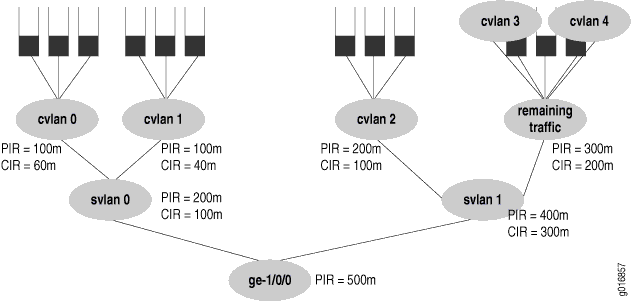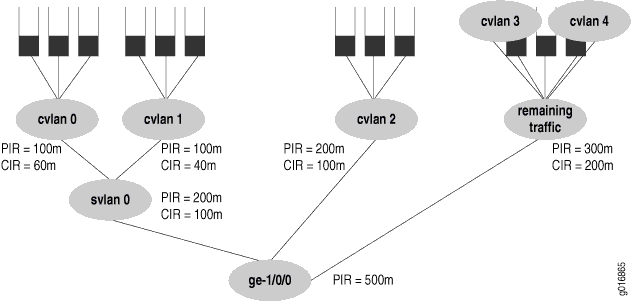Controlling Remaining Traffic
You can configure many logical interfaces under an interface.
However, only a subset of them might have a traffic control profile
attached. For example, you can configure three logical interfaces
(units) over the same service VLAN, but apply a traffic control profile
specifying best-effort and voice queues to only one of the logical
interface units. Traffic from the two remaining logical interfaces
is considered remaining traffic. To configure
transmit rate guarantees for the remaining traffic, you configure
the output-traffic-control-profile-remaining statement
specifying a guaranteed rate for the remaining traffic. Without this
statement, the remaining traffic gets a default, minimal bandwidth.
In the same way, the shaping-rate and delay-buffer-rate statements can be specified in the traffic control profile referenced
with the output-traffic-control-profile-remaining statement
in order to shape and provide buffering for remaining traffic.
Consider the interface shown in Figure 1. Customer VLANs 3 and 4 have no explicit traffic control profile. However, the service provider might want to establish a shaping and guaranteed transmit rate for aggregate traffic heading for those customer VLANs. The solution in to configure and apply a traffic control profile for all remaining traffic on the interface.

This example considers the case where customer VLANs
3 and 4 have no explicit traffic control profile, yet need to establish
a shaping and guaranteed transmit rate for traffic heading for those
customer VLANs. The solution is to add a traffic control profile to
the svlan1 interface set. This example builds on the earlier
example and so does not repeat all configuration details, only those
at the service VLAN level.
[edit class-of-service interfaces]
interface-set svlan0 {
output-traffic-control-profile tcp-svlan0;
}
interface-set svlan1 {
output-traffic-control-profile tcp-svlan1; # For explicitly shaped traffic.
output-traffic-control-profile-remaining tcp-svlan1-remaining; # For all remaining traffic.
}
[edit class-of-service traffic-control-profiles]
tcp-svlan1 {
shaping-rate 400m;
guaranteed-rate 300m;
}
tcp-svlan1-remaining {
shaping-rate 300m;
guaranteed-rate 200m;
scheduler-map smap-remainder; # this smap is not shown in detail
}
Next, consider the example shown in Figure 2.

In this example, ge-1/0/0 has three logical
interfaces (unit 1, unit 2, and unit 3), and SVLAN 2000,
which are covered by the interface set:
Scheduling for the interface set
svlan0is specified by referencing anoutput-traffic-control-profilestatement which specifies theguaranteed-rate,shaping-rate, anddelay-buffer-ratestatement values for the interface set. In this example, the output traffic control profile calledtcp-svlan0guarantees 100 Mbps and shapes the interface setsvlan0to 200 Mbps.Scheduling and queuing for remaining traffic of
svlan0is specified by referencing anoutput-traffic-control-profile-remainingstatement which references ascheduler-mapstatement that establishes queues for the remaining traffic. The specified traffic control profile can also configure guaranteed, shaping, and delay-buffer rates for the remaining traffic. In this example,output-traffic-control-profile-remaining tcp-svlan0-remreferencesscheduler-map smap-svlan0-rem, which calls for a best-effort queue for remaining traffic (that is, traffic on unit 3 and unit 4, which is not classified by thesvlan0interface set). The example also specifies aguaranteed-rateof 200 Mbps and ashaping-rateof 300 Mbps for all remaining traffic.Scheduling and queuing for logical interface
ge-1/0/0 unit 1is configured “traditionally” and uses anoutput-traffic-control-profilespecified for that unit. In this example,output-traffic-control-profile tcp-ifl1specifies scheduling and queuing forge-1/0/0 unit 1.
This example does not include the [edit interfaces] configuration.
[edit class-of-service interfaces]
interface-set {
svlan0 {
output-traffic-control-profile tcp-svlan0; # Guarantee & shaper for svlan0.
}
}
ge-1/0/0 {
output-traffic-control-profile-remaining tcp-svlan0-rem;
# Unit 3 and 4 are not explicitly configured, but captured by “remaining”
unit 1 {
output-traffic-control-profile tcp-ifl1; # Unit 1 be & ef queues.
}
}
Here is how the traffic control profiles for this example are configured:
[edit class-of-service traffic-control-profiles]
tcp-svlan0 {
shaping-rate 200m;
guaranteed-rate 100m;
}
tcp-svlan0-rem {
shaping-rate 300m;
guaranteed-rate 200m;
scheduler-map smap-svlan0-rem; # This specifies queues for remaining traffic
}
tcp-ifl1 {
scheduler-map smap-ifl1;
}
Finally, here are the scheduler maps and queues for the example:
[edit class-of-service scheduler-maps]
smap-svlan0-rem {
forwarding-class best-effort scheduler sched-foo;
}
smap-ifl1 {
forwarding-class best-effort scheduler sched-bar;
forwarding-class assured-forwarding scheduler sched-baz;
}
The configuration for the referenced schedulers are not given for this example.
